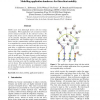Free Online Productivity Tools
i2Speak
i2Symbol
i2OCR
iTex2Img
iWeb2Print
iWeb2Shot
i2Type
iPdf2Split
iPdf2Merge
i2Bopomofo
i2Arabic
i2Style
i2Image
i2PDF
iLatex2Rtf
Sci2ools
CSREAPSC
2006
2006
Modelling Application Handovers For Thin-Client Mobility
Mobile users need lightweight devices with low energy consumption. When applications are executed on remote servers instead of locally on the end-user's device, the weight of the device can be reduced and battery lifetime can be extended. Therefore, thin-clients are ideally suited for mobile users. All calculation logic is removed from the device and the communication with the application server is accomplished by a remote desktop protocol. Reactions to user events can appear on the screen only after a two-way path delay, so application responsiveness can decrease if the user moves further away from his server. To enable ubiquitous thin-client computing with satisfying user responsiveness, the application should make a parallel movement with the mobile user. This paper focusses on the handover between two application servers. A model is presented for the design of a thin-client network that meets the requirements of moving users and the resulting number of handovers is shown. Thr...
| Added | 30 Oct 2010 |
| Updated | 30 Oct 2010 |
| Type | Conference |
| Year | 2006 |
| Where | CSREAPSC |
| Authors | Pieter Simoens, Lien Deboosere, Davy De Winter, Filip De Turck, Bart Dhoedt, Piet Demeester |
Comments (0)

